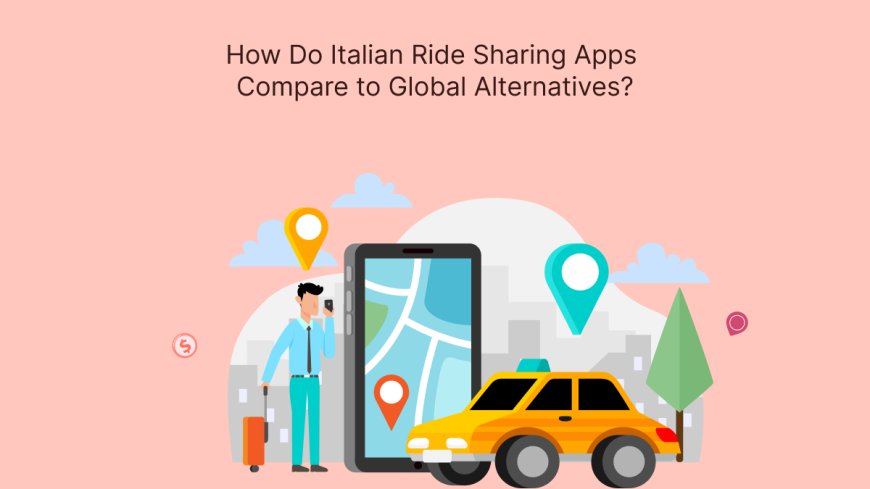How Do Italian Ride Sharing Apps Compare to Global Alternatives?
Discover how Italian ride-sharing apps stack up against global giants. This article explores unique features, local advantages, and cultural nuances that set Italy’s ride-sharing options apart, offering insights for travelers and anyone interested in app development.

Italy, known for its rich cultural heritage, stunning landscapes, and bustling cities, also has a growing ride-sharing market. With a strong tourism industry and cities often filled with narrow, historic streets, uber in Italy presents unique challenges and opportunities for ride-sharing platforms. So how do Italian ride-sharing apps measure up against global giants like Uber, Lyft, and Bolt? Let’s explore what sets them apart, and how these local apps cater specifically to the Italian market.
The Unique Landscape of Ride-Sharing in Italy
The Italian ride-sharing market has been shaped by regulations, urban layouts, and a growing demand for alternative transportation. Unlike countries where ride-sharing giants have dominated, Italy has had a more complex relationship with global platforms due to strict local regulations and protections for traditional taxis. This regulatory environment has created space for locally tailored apps that focus on compliance with Italian law while catering to specific regional needs.
For instance, Italian cities like Rome, Milan, and Florence have stringent rules regarding which vehicles can offer ride-sharing services, leading to a market where companies often work closely with licensed taxi drivers. This is particularly true in tourist-heavy cities, where local apps cater to the needs of both residents and visitors.
Key Italian Ride-Sharing Apps
Italy has its own ride-sharing apps that provide services similar to Uber but with unique twists to fit the Italian market. Here are some of the popular options:
-
Free Now
Free Now, a European app, operates in Italy and partners with licensed taxi drivers rather than private drivers. Free Now allows users to order a traditional taxi via a digital platform, making it easy for travelers and locals to access reliable transportation. This aligns with Italian regulations while offering app-based convenience similar to global ride-sharing platforms. -
It Taxi
As one of Italy’s largest ride-hailing services, It Taxi connects users to licensed taxis in over 100 cities. The app is widely used by Italians and tourists alike, offering GPS tracking, estimated fares, and various payment options. It Taxi emphasizes working with existing taxi infrastructure, appealing to riders who want a more localized and regulation-compliant experience. -
MyTaxi
Owned by the Free Now group, MyTaxi operates similarly to Free Now but with some distinct features that appeal specifically to urban Italian users. In cities like Rome and Milan, MyTaxi provides services that match the familiarity of local taxis with the convenience of on-demand ride requests, competitive pricing, and in-app payments. -
Scooterino
For those looking to experience Italy on two wheels, Scooterino is a unique Italian ride-sharing app that allows users to book rides on scooters. Given Italy’s narrow streets and dense traffic, scooters are a popular mode of transportation, and this app provides an option that global apps like Uber typically don’t offer. Scooterino pairs riders with vetted drivers for scooter rides around urban areas, making it a popular choice for short-distance travel. -
BlaBlaCar
While not exclusively Italian, BlaBlaCar is popular in Italy for intercity travel. This carpooling app connects drivers with passengers who need to travel longer distances, offering a cost-effective alternative to trains and buses. With a focus on shared travel, BlaBlaCar has built a solid user base across Italy, especially for weekend getaways and holiday travel.
Comparing Italian Ride-Sharing Apps to Global Alternatives
Italian ridesharing apps in Italy, in contrast to global giants like Uber and Lyft, tend to focus heavily on local compliance and the existing taxi industry. This has led to several notable differences:
-
Regulatory Compliance: Italian apps like Free Now and It Taxi operate strictly with licensed taxis, which can mean higher fares but greater alignment with Italian laws. This differs from Uber, which typically relies on private drivers, often creating regulatory friction.
-
Local Features: Italian apps are more likely to offer services tailored to Italy’s unique urban environment, such as Scooterino for scooters and BlaBlaCar for intercity carpooling. These features enhance accessibility in Italy’s historic cities and offer alternatives not usually available on international apps.
-
Pricing and Payment: Local ride-sharing apps may offer slightly higher fares due to their partnership with licensed taxis, but they also provide options for mobile payments, upfront pricing, and cashless transactions, making them convenient and user-friendly.
-
User Experience: Italian apps tend to focus on customer experience with localized features, multilingual support, and tourism-friendly services. For example, Scooterino’s scooter-based travel provides an Italian feel, allowing users to enjoy a culturally authentic experience.
Conclusion
While Italian ride-sharing apps may not match the scale of Uber or Lyft, they cater to Italy’s unique landscape, regulations, and cultural nuances. By integrating seamlessly with local taxi networks and offering scooter and carpool options, these apps have created a space of their own. Whether you’re a local or a visitor, Italian ride-sharing apps offer a robust alternative to global platforms with services that are both reliable and tailored to the Italian market.
If you’re considering creating your own on-demand app for a specific region or purpose, working with an on-demand app development company can help you build a platform that meets local requirements while providing a seamless user experience. With the right partner, you can tap into new markets and create a specialized, competitive app tailored to regional needs.
